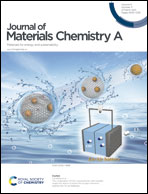Effective 3D open-channel nanostructures of a MgMn2O4 positive electrode for rechargeable Mg batteries operated at room temperature†
Abstract
Room-temperature operations of rechargeable Mg coin-cell batteries have been achieved using a Mg alloy negative electrode and a spinel MgMn2O4 (MMO)-positive electrode. The present work focuses on clarifying the effects of the physiochemical properties of the MMO powder including the specific surface area (SBET) and porosity of the positive electrode on Mg battery performances in practical applications. Finally, optimal specific surface area and porosity parameters were obtained that ensured excellent battery performances as a standard coin-cell at room temperature. A typical MMO powder synthesized using a modified sol–gel method with propylene oxide-driven complex polymerization had a large SBET > 200 m2 g−1, and more than 90% porosity with a triple-tiered 3D open-channel network. Here we evaluated the discharge capacity and the cyclability for room-temperature operation as a function of SBET in a full cell with a Mg negative electrode as well as half cells with a carbon graphite electrode. Irrespective of whether half cells or a full cell was used, the initial discharge capacity was found to depend linearly on the SBET of the porous MMO powder in a Mg tetrakis(hexafluoroisopropyl)borate/triglyme electrolyte with a wide potential window, ΔE > 3.6 V. Eventually, the maximum discharge capacity of 220 mA h g−1 was realized at 25 °C in the full cell using the 3D open-channel nanostructure with SBET = 236 m2 g−1. The cyclability in the full cell with the Mg alloy negative electrode, however, degraded with the increasing SBET, while no cyclability degradation was observed in the half cell with the carbon electrode. A possible mechanism is discussed regarding passivation of the Mg alloy electrode in discharge/charge cycles.



 Please wait while we load your content...
Please wait while we load your content...